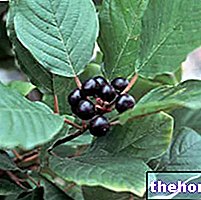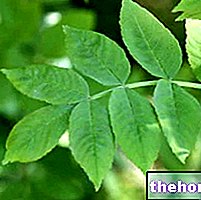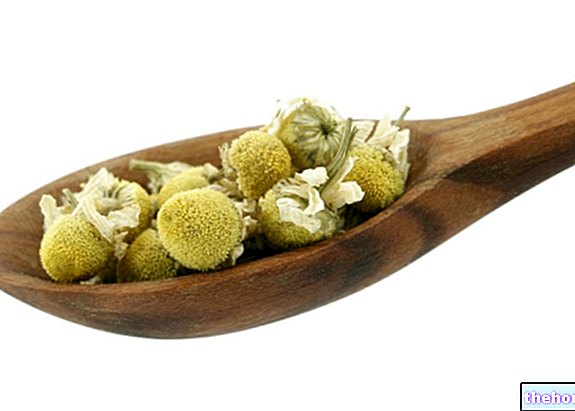Introduction
Among the medicinal plants indicated for the treatment of venolymphatic insufficiency, a note of merit goes to the sweet clover: this plant, in fact - due to the abundant quantity of coumarins - exerts a powerful phlebo-tonic action, as well as boasting anti-inflammatory, atiedemigenic and diuretic.

Sweet clover in history
As we have seen, the sweet clover is characterized by its richness in coumarins: the phytotherapeutic importance of this plant was observed by chance by studying cases of haemorrhagic syndrome in grazing animals. It was observed that the cattle, after ingesting large quantities of sweet clover and clover deteriorated, had rather serious side effects, as well as being predisposed to bleeding. The hemorrhagic syndrome was a consequence of the decrease in plasma prothrombin levels, linked to the presence of coumarin derivatives in the sweet clover plants ingested by the animals. In those years, Dr. Link of the University of Wisconsin, after learning the reason that triggered the syndrome in animals, synthesized dicumarol for the first time, which soon became the precursor of synthesis antiaggregants of the dicumarolic type.
It should be pointed out, however, that sweet clover does not act directly on blood coagulation, but performs its action at the level of the venous walls, increasing their tone and reducing capillary permeability (aescin-like action). [adapted from Dictionary of Phytotherapy and Medicinal Plants, by E. Campanini]
Botanical genres
The common sweet clover (Fam. Leguminose Papilionaceae), is known in botany by the name Melilotus officinalis, a plant which, among other things, does not differ very much from the species M. very high.
The two species differ mainly in the structure of the ovary and the pods of the plant:
- Melilotus officinalis (Europe with a temperate climate): legumes and hairless ovary, pod consisting of transverse veins;
- Melilotus altissima (Germany): pubescent legumes and ovary, pod characterized by reticular veins.
Let M. officinalis, that M. very high they are made up of the same phytocomplex, therefore the distinction of the two species has no repercussions in the phytotherapeutic field.
Among other species of sweet clover are also remembered M. coerulea And M. alba, grown primarily for popular medical use.
Botanical analysis
The sweet clover is an annual herbaceous plant, biennial or perennial, about 80 cm tall: the stem is hollow, branched and rather slender and thin, covered by alternate leaves composed of three typically lanceolate leaflets, ending with a serrated margin. The flowers, fragrant and grouped in axillary racemes, appear very small, very numerous, yellowish in color; only rarely, the corolla is streaked with bluish or lilac.
Belonging to the Leguminosae family, the fruits of the sweet clover are legumes: the pods, yellow or brownish, appear globular, erect, and contain a couple of seeds.
Active principles
In phytotherapy, the flowering tops and leaves of the sweet clover plant are used: the aerial parts contain mainly coumarins (0.4-1%), in particular 5,6-benzo-β-pyrone, melilotin, coumarin glycosides of the acid o-hydroxy cinnamic (melilotoside), flavonoids (kaempferol, quercetin), terpene molecules, saponins, melilogenin (substance derived from oleanene) and tannins.
Therapeutic properties
As mentioned, the main activity of sweet clover is exploited to counteract venous insufficiency; however, the eupeptic, sedative and astringent activities are also used to combat digestive disorders of a nervous nature, difficulty falling asleep and mild sleep disturbances in general.
In popular medicine, the pleasant and aromatic infusion of sweet clover was used as a remedy against headaches and to facilitate digestion, as well as to promote sleep: so much so that its activity was compared to that of chamomile.
Since the phytocomplex also consists of tannins, at the topical level the sweet clover extract is used in the formulation of eye drops and mouthwashes, as well as being suitable for gargling.
The chemical components that characterize the phytocomplex act in synergy, also carrying out healing activities: for this reason, the extract is also used to promote wound healing.
Recent studies have also observed an "antirheumatic activity - albeit mild - associated with sweet clover (topical application).
Coumarin compounds
We have seen that it is coumarins that represent the main chemical constituent of the melilot phytocomplex. The ingestion of parts of sweet clover or of the whole deteriorated plant can generate rather serious side effects; in fact, in the spoiled sweet clover, the coumarins undergo a transformation into dicumarol (hydroxy-4-coumarin), a molecule which, by decreasing the synthesis of prothrombin, generates a marked anticoagulant effect.
Coumarin is a specific symptomatology used in veno-lymphatic insufficiency: coumarins stimulate the endothelial reticulum system and at the same time enhance the proteolytic activity of macrophages. Consequently, the sweet clover is able to stabilize the erythrocyte membrane thanks to the better oxygenation of the tissues.
The topical application of sweet clover extracts is useful in the treatment of edema (of inflammatory etiology) and in the treatment of capillary fragility: these activities are made by the improvement of venous return and lymphatic circulation, as well as by the decrease in the permeability of the vessel wall ( anti-inflammatory and anti-edematous virtues).
For all the potentialities just described, sweet clover finds application in the treatment of hemorrhoids, varicose veins, lymphatic stasis, ulcers of the lower limbs and thrombophlebitis.
Sweet clover: toxicity
At therapeutic doses, sweet clover does not generate any side effects; however, its intake is not recommended in case of ascertained or presumed hypersensitivity to one or more chemical constituents of the phytocomplex.
When the sweet clover extract is abused, the patient can complain of nausea, headache and dizziness: it can cause narcosis.
Finally, being made up of coumarins, the sweet clover extract is not recommended in case of concomitant intake of salicylates and anticoagulants.
Sweet clover in brief, summary on Sweet clover "
Select plant Fir Acacia Acerola Sorrel Yarrow Yarrow Yarrow Aconito Adatoda Garlic Agnocasto Agrimonia Alchemilla Alkekengi Aloe Altea Witch Hazel Ammi or Visnaga Pineapple Andrographis Anemone Pulsatilla Angelica Anise Star Anise Japanese Star Anise Bitter Orange Bitter Areca Arnica Harpagophytum Arpagophyte Artemisia Asteragus Basil Asparagus Asparagus Peruvian Asparagus Asparagus Asparagus Hawthorn Boldo Borage Shepherd's Purse Boswellia Bucco Butea superba Cocoa Coffee Cajeput Calamus Calamus Marigold Camedrio Chamomile Roman Chamomile Camphor Cinnamon Ceylon Maidenhair Capuchin Artichoke Cardamom Cardiac Thistle Asian Thistle Carvi Cascara Cassia Catecu Catha Cabbage Celandine Chicory Centaurea Cinnamon Cypress Celandine Chives Cypress Coca Cola Colchico Combreto Condurango Comfrey Coriander Cranberry Barberry American Chrysanthemum Cumin Turmeric Damiana Digital Dioscorea Drosera Dulcamara Dunalilella Echinacea Eder a Ephedra Elenio Eleutherococcus Helichrysum Evening primrose Horsetail Alfalfa Erica Euphrasia Erisimo Escolzia Eucalyptus Farfara Farfaraccio Calabar bean Fenugreek Fennel Phytolacca Frangola Ash Fumaria Japanese Mushrooms Galega Ganoderma lucidum Garcinia Cambogia Mulberry Gentian Broom Ginkgo Ginkgo Guipana Guipana Gynestra Ginkgo Hibelia Gymnasium Hibiscus Guarulp St. John's Wort Horse Chestnut Ispaghul Hyssop Jaborandi Kava kava Konjac Laminaria Cherry Laurel Lavender Lemongrass Lespedeza Lovage Icelandic Lichen Lemon Flax Lippia Licorice Lobelia Hops Maca Marjoram Maize Mallow Manna Marrubio Marrubio d "water Matè Melaleuca Meliloto American Lemon balm Myrtle Myrama Walnut Nutmeg Walnut vomica Olive tree Meadowsweet Ononide Opuntia Oregano Orthosiphon Nettle Poppy Papaya Parietaria Feverfew Passiflora Chilli Perilla Periwinkle Phyllanthus Plantain Picrorhiza Pilosella Pino Pisci dia Podofillo Polygala Grapefruit Parsley Psyllium Pueraria mirifica Butcher's broom Pygeum Quassia Oak Rhubarb Ratania Rauwolfia currant Castor bean Rhodiola Rosehip Rosemary Rue Willow Sarsaparilla Sage Elderberry Sassafras Sedum Ergot Senna Serenoa Repens Soybean Solidago Tansy Taraxus Tamarind Tamarind Tamarind Tamarind Tamarindo Ursina Valerian Vanilla Mullein Verbena Veronica Viburnum Vinca Pansy Mistletoe Vine Withania Yohimbe Saffron Ginger Pumpkin Select disease Juvenile Acne Rosacea Tinnitus Tinnitus Aerophagia Tendon Affections Afonia Aphthae Algias Functional Halitosis Breastfeeding Allergy Anemia Anguish Anxiety Arteriosclerosis Asthrosis Asthrosis Arthritis Arthritis Men Sex Woman Blepharitis and Conjunctivitis Eye bags Bronchitis Gallstones Kidney stones Salivary stones Baldness Androgenetic Candida Fragile hair Caries Headache Cellulitis Motion sickness Cystitis C limaterio Cholecystopathy High cholesterol Ulcerative colitis Colonoscopy Contusions Hematoma Convalescence Couperose Depression Dermatitis Diaper dermatitis Diabetes Diarrhea Erectile dysfunction Dyslipidemia Dysmenorrhea Dyspepsia Disturbances of vision Hemorrhoids Epistaxis Herethism Heart disease Fever Fibromyalgia Gastro-intestinal disease Flatulence Hypertension Fibromyalgia Gastrointomnia Jaundice Laryngitis Renal lithiasis Toothache Sore throat Thinness Menopause Meteorism Mononucleosis Alzheimer's disease Crohn's disease Nausea Vomiting Obesity Dark circles Onychomycosis Osteoporosis Dry skin Periarthritis Piorea Low pressure Prostatitis Psoriasis Colds Breast fissures Anal fissures Gastro-nasal rhinitis Senescence Premenstrual Syndrome Sinusitis Quit smoking Overweight Fatty liver Constipation Stomatitis Stress Cough Triglycerides high Ulcer Burns Nails Brittle flashes Heat Warts Dizziness Properties herbal Tanning Abortive adaptogenic Aphrodisiac bittering analgesic anesthetic anorectics analgesic antacid anti-allergic anti-asthmatic Antibiotic catarrh Anticellulitiche anticonvulsant Antidiaforetiche antidiarrheal edematous anthelmintic antiemetic Antiemorroidarie antiphlogistic Antiidrotiche Antinevrotiche Antioxidants antipyretic antirheumatic antiscorbutic Antiseptic antispasmodic anti-uric Aperitive Flavoring Astringent Balsamic Bechiche Capillarotrope Cardiotonic Carminative Cathartic Caustics Healing Cholagogues Choleretic Dyes Decongestants Deodorants Purifying Diaphoretic Cleansers Disinfectants Detoxifiers Thirst quenching Diuretics Exciting Emetics Emmenagogues Emollients Hemostatic Energies Hepatoprotectors Expectorants Eupepticus Moisturisers Galactosensitizers lanti Hypertensive Hypnotic Hypoglycemic Hypotensive Irritants Laxatives Soothing Narcotic Nerves Nutrients Odontalgic Pectoral Purgative Revulsive Remineralizing Refreshing Rubefacient Scialagoghe Sedative Soporifugas Sneezing Stomachic Stomatics Narcotic Vascular Tightenitis




























